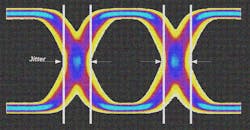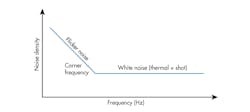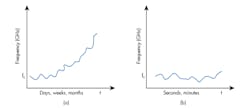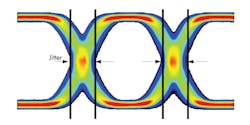Consider LPNAs for Your Next Design
Download this article as a .PDF
Noise is a phenomena that is fundamental to electronics. Its random and non-deterministic behavior can cause obstacles in the design and characterization of circuitry. There are a variety of noise sources that are dependent upon the medium (e.g., vacuum tubes, solid-state devices, and crystal oscillators). Some of the major noise contributors are thermal, shot, and flicker noise. Essentially, the products of all the noise sources actualize as time-dependent, random fluctuations in amplitude and phase—also known as amplitude modulation (AM) and phase modulation (PM) noise. These form the lower limit of a signal that can be detected and amplified.
Phase noise has become a critical parameter in communications systems and radar due to technological advances that demand higher spectral purity over wider bandwidths, along with better sensitivities. In these cases, design engineers choose oscillating sources with low phase noise. However, they may overlook the effects of residual, or additive, phase noise. Low-phase-noise amplifiers (LPNAs) offer the capability of reducing any additive phase noise effects, thereby saving efforts and increasing cost-effectiveness.
White Noise (Shot and Thermal)
Noise on the particle level can be expressed by the fluctuations in the numbers or velocities of groups of mobile electrons. It can manifest itself in a number of ways, depending on the medium leveraged.1 Thermal noise, also known as Johnson-Nyquist noise, describes the intrinsic noise of an electrical conductor in terms of its temperature and resistance. It is a kinetics phenomenon that involves collisions between the free electrons of a substance and its lattice at any temperature above absolute zero (K= 273°C).1
At the small signal level in solid-state electronics, noise figure (NF) can be expressed in terms of the thermal noise of the semiconductor. NF is the decibel conversion of the noise factor. For an amplifier, the noise factor is the ratio of the noise power to the available thermal noise power of the source resistance. Thermal noise, which is fundamental to the material, is often white noise at equal intensities across frequencies.
Shot noise is also spectrally white. It is a result of the fluctuations in electrical currents, due to the random passage of discrete electrical charges through the potential barriers in p-n junctions.2 Both fundamental and frequency-independent noise sources are often considered in the NF of an amplifier, and therefore weigh into the sensitivity of a receiver.
Flicker (1/f) Noise
Flicker noise, which occurs at low frequencies, is believed to be an extrinsic source of noise caused from surface imperfections, contaminants, and defects in thin film and polycrystalline devices. These “flickers” were originally discovered by Johnson at Bell Labs during his study of vacuum tubes. The fluctuations observed at low frequencies were notably larger than what is expected from shot and thermal noise.
The frequency at which this phenomena occurs is dependent on the type of device and varies from a few Hz for some bipolar devices to 100 MHz for gallium-arsenide (GaAs) field-effect transistors (FETs).2 Figure 1 shows a general noise frequency spectrum of an amplifier in which flicker noise dominates the low-frequency band, while frequency-independent white noise (shot and thermal) may reside at intermediate and high frequencies.
Phase Noise
Phase noise, which is produced by oscillators, is essentially a blanket term that accounts for short-term, random-frequency instabilities. It can be a product of flicker noise and white noise. This parameter is expressed in units of dBc/Hz, or noise per unit bandwidth at a given offset from the carrier frequency.
Short-Term vs. Long-Term Frequency Stability
Ideally, an oscillator would produce a perfect sine wave with no phase or amplitude fluctuations. Stability can be defined as the statistical estimate of the frequency or time fluctuations of a signal over a given time interval. It can be broken down into long-term stability and short-term stability.4 Long-term stability is measured over intervals ranging from minutes to years, while short-term stability is often associated with fluctuations that occur within 100 seconds (Fig. 2).
Random vs. Spurious
Both phase noise and spurious signals are short-term and emit at non-integer multiples of the generated output frequency. On a spectrum analyzer, spurious signals can be seen with relatively high power. They are generally continuous and unaffected by averaging.
Phase noise, which is random, is generally a lower energy emission. Its variance around the mean can decrease with averaging.5 In essence, spurious signals are systematic and deterministic in origin, while phase noise is not.
Additive (Residual) Phase Noise
While leveraging NF in the analysis of a transmitter/receiver system has a great deal of merit, it does not account for phase noise and additive phase noise. Typically, NF is measured by applying a white noise source to the input of the device-under-test (DUT). This approach does offer some insight into the added noise of a low-noise amplifier (LNA) in a receive chain. However, it does not take into account the injected carrier signal in a real application (and thus any noise near the carrier frequency), nor any potential large-signal conditions.
Figure 3 shows a basic communications system. Here, the local oscillator (LO) is the source of the phase noise. The LO signal then passes through other components, which have the potential to add to the noise. Typically, amplifiers are subject to tests for additive phase noise, as they can have a higher flicker-noise-corner frequency than the LO—depending on the transistor topology and the substrate (JFET, BJT, GaAs FET, CMOS, etc.). This effectively increases the noise floor of the system and decreases the sensitivity of a receiver.
A designer tasked with meeting particular phase noise requirements in a system may need to obtain information concerning the phase noise and additive phase noise in a circuit to identify the dominant noise source in a system. LPNAs can remedy situations in which an original signal can become hidden in both the phase noise and additive phase noise of a receiver or transmitter.
Bit-Error-Rate Effects of Phase Noise and Additive Phase Noise
Bit-error-rate (BER) is a parameter leveraged in wireless communications to measure the amount of data that gets lost from a transmission due to noise and interference. For instance, a BER of 10−9 can be expressed as one bit error for every 109 bits received. Poor BERs can lead to poor audio/video quality, lost data, or retransmissions.9 Designers attempt to minimize the BER in order to optimize the spectral efficiency, or information rate transmitted over a bandwidth, of a system using the least amount of energy per bit to induce a better Quality of Service (QoS).7
The global market for BER testers is approaching $1 billion USD this year due to faster data throughputs, higher transmission capacity, and an increased focus on quantifying the reliability of a communication system. All of these factors call for the minimization of any noise at both the transmitter and receiver.12
One method to improve BER is to reduce the data rate to improve the overall transmission time. However, this approach decreases the data throughput. Another method involves choosing a strong signal through slow and robust modulation or line coding schemes and applying channel coding schemes, such as redundant forward error correction codes.11 These are both external adjustments that can be performed (and sometimes need to be performed) due to the distortions and interference in the system often caused by phase noise and additive phase noise. Limiting white noise and pink noise within the communications system may simplify the design process.
Phase noise directly causes jitter and reciprocal mixing, which in turn increases the BER. Reciprocal mixing occurs when the noise sidebands of the LO mix with strong signals that are close in frequency to the wanted signal. This scenario produces unwanted noise products at the intermediate frequency and degrades the receiver sensitivity.8. The short-term random frequency variations cause random time-domain jitters (packet delay variation), or deviations from the period of a signal, limiting the selectivity of the receiver (Fig. 4).
Clutter in Radar
Radar applications leverage the Doppler shift, or frequency shift of moving objects, in order to detect aircraft or vehicles in the vicinity.
The Doppler frequency shift is directly proportional to the velocity of the object and the transmitter’s carrier frequency, defined by the following equation:
|fD| = 2 · vr/λ = 2 · vr · ftx/c0
Where fD is the Doppler shift;
ftx is the transmit frequency;
c0 is the speed of light; and
vr is the speed of the aircraft.
A few simple calculations from the equation can illuminate the approximate minimum velocity of an object necessary to be detected by certain radar by ensuring that the Doppler shift is beyond the common 10-kHz flicker noise corner where flicker noise (and potentially phase noise and additive phase noise) dominates.
For instance, military X-band radar has a transmit frequency of approximately 10 GHz. Object speeds below 300 mph expect a Doppler shift below 10 kHz. L- and S-bands (~2 GHz) are commonly used for commercial/military air traffic control (ATC) and air route surveillance radars (ARSRs). Object speeds at the same 300 mph expect a Doppler shift of approximately 1800 Hz. The target return can easily get lost in the phase noise and additive phase noise of the LO and amplifier.
Additionally, motion from the landscape, such as wind, rain, birds, and trees, could cause clutter that can make it more difficult to demodulate a transmission. A common solution to this is to employ narrowband receive filters to reduce clutter. But this approach limits the data throughput and can be an obstacle in terms of obtaining information on slow moving objects. For instance, an unmanned aerial vehicle (UAV) equipped with sophisticated apparatus on an Intelligence, Surveillance, and Reconnaissance (ISR) mission may require both high data throughputs over a larger bandwidth while detecting slow moving objects.
Conclusion
With the increase in bit rates in technologies across a wide array of industries, low-phase-noise oscillators and LPNAs can mitigate the effects of both phase noise and additive phase noise. They can at best solve major issues in data transmissions without the need to increase transmitter power or antenna diameter (of a ground station), or simply be another helpful tool to increase the sensitivity of the receiver. In both cases, time and money can be saved.
Accounting for white noise can be an effective model in applications that can both operate under small-signal conditions and can filter out the noise near the carrier frequency without losing a transmission. However, many applications require more. Amplifiers often add significant residual phase noise that can go overlooked, since many systems are optimized according to the phase noise from the source (LO). It is important to assess the overall system noise floor in real scenarios. Oftentimes, that can call for limiting both phase noise and additive phase noise.
Tim Galla, Pasternack
References
1. From "Introduction to Noise in Solid State Devices" NBS Tech Note.
2. https://www.ieee.li/pdf/viewgraphs_mohr_noise.pdf
3. http://ecee.colorado.edu/microwave/docs/theses/Thesis_MilosJankovic.pdf
4. http://tf.nist.gov/general/pdf/1498.pdf
5. http://www.edn.com/design/test-and-measurement/4436033/2/8-Ways-to-clarify-spurious-emissions
6. https://pdfs.semanticscholar.org/17b6/c21f99efb18704cd142b376ae6533b1d343b.pdf
7. http://www.eetimes.com/document.asp?doc_id=1225313
8. http://138.4.37.1/~jambrina/pll/www.radiolab.com.au/DesignFile/PNRef/rx1.htm
9. http://www.edn.com/design/test-and-measurement/4381984/BER-measurements-reveal-network-health
10. http://www.holzworth.com/Aux_docs/PhaseNoise_Article_MWJ_Jun08.pdf
11. http://www.ijfcc.org/papers/312-A163.pdf
12. http://www.prweb.com/releases/bit_error_rate_testers/functional_bert/prweb9369204.htm




